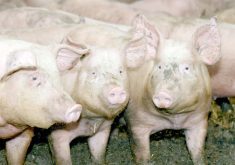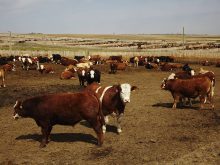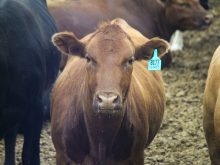Canada could process nearly one million head of cattle for the export market by 2020.
Canada Beef Export Federation chair Gib Drury says the 450,000 tonnes of beef would be worth $1.5 billion to the industry.
Drury told the federation’s annual meeting in Calgary Sept. 17 that Canada’s best export year was 2002, when more than 517,000 tonnes were shipped to about 60 countries. That was all undone the following year when the discovery of BSE in Canada closed international markets.
Although trade is now normalizing, he said, there have been disappointments and lessons learned.
Read Also

Agritechnica Day 3: Hybrid drive for a combine, data standards keep up to tech change and tractors of the year
Agritechnica 2025 Day 3: Hybrid drive for a combine, data standards keep up to tech change and tractors of the year.
“Cattle raising and production and beef marketing are two completely different worlds and it requires organizations like CBEF to bridge the gap between them,” he said.
Strict restrictions continue in once favourable markets such as Japan, South Korea and Mexico.
Canada regained access to China last June ahead of the United States, but no beef will show up there until regulatory issues are agreed upon and processing plants are certified as acceptable to the Chinese.
“It is so sweet to be the first country in the world that has BSE to regain access to China’s 1.3 billion consumers,” Drury said. Canada shipped 2,700 tonnes of beef to China in 2002.
The agreement to resume beef trade will include a staged approach on industrial tallow and meat from animals younger than 30 months, said Stephanie Dai of the Hong Kong CBEF office.
She said Canada needs to build a superior quality image, as well as maintain good service and support to business partners with competitively priced cuts and consistent quality.
Hong Kong and Macau exports peaked at 20,000 tonnes in 2005, and an agreement was reached in 2009 to accept more cuts on a graduated basis from cattle younger than 30 months. These two regions had accepted 9,200 tonnes by the end of June.
Frustration has continued with Japan, where restrictions are tight. Canada and the U.S. have asked the Japanese government to lift the restriction on beef from animals 21 to 30 months old, although no real movement has taken place. Political upheaval in Japan has stalled the resolution of various international issues, although it is hoped some talks may start this fall.
“We don’t know how much time it will take to move from working talks to a final agreement,” said Tomoshige Sakamoto of the Japan CBEF office.
South Korea was once a good market, but it remains closed. The issue has gone to the World Trade Organization and a report is expected next year, said CBEF representative Amos Chin.
The U.S. has been back in Korea for the last two years, but Korean farmers and consumer groups have opposed the American request for expanded access.
“The new Korean minister has made it clear it is not ready to grant U.S. access to (animals) over 30 months of age,” Chin said.
The country has also suffered from the global economic crisis of the last two years, and consumer spending remains conservative.
Canadian beef sales to Taiwan have slowed because it can be as much as 25 percent more expensive than other beef, said Stella Siao of the Taiwan CBEF office.
Taiwan also continues to block access for Canadian bone-in-beef and offal while giving access to the U.S.. Chin said it wants more information on Canada’s 17th BSE case.
Mexico maintains good relations with Canada, although it does not accept beef from cattle older than 30 months. It is waiting for the results of a Canadian Food Inspection Agency risk assessment report before it agrees to expand access.
“If it is satisfactory, it will be difficult for Mexico not to open the border to OTM 30 products,” said Mauricio Ruiz of the Mexico office.
Mexico’s largest Canadian imports occurred in 2004 when it bought 87,000 tonnes. It bought 25,000 tonnes in the first six months of this year, up 34 percent from the same period last year.
Ruiz said that could increase by another 12,000 tonnes if Mexico accepts beef from mature animals.















